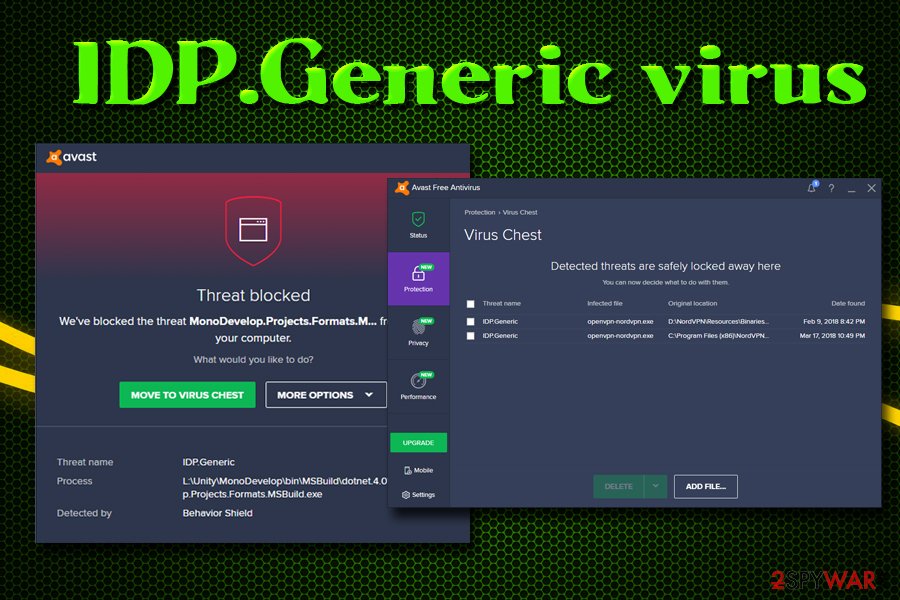IDP.Generic is a heuristic detection term for data-stealing malware used by some anti-virus software providers


IDP.Generic is a term is that users can encounter on pop-up windows from anti-malware applications (mainly AVG and Avast), which discover something suspicious on the computer. The detection name is heuristic, which means that the AV found behavioral patterns rather unusual for a regular file that could be malicious. In other terms, it stands for Identity Detection Protection, which means that an attempt to steal your sensitive information was performed by malicious actors.
However, due to behavioral analysis mechanisms, IDP.Generic can also be a false-positive, which means that the file, a website, or a script that was detected is actually safe. This typically happens when the security software is outdated or partially broken. As a result, users noticed that legitimate tools, such as dialer software, manufacturer’s diagnostic tools,[1] gaming platform Steam, communication app Discord, and other harmless apps are marked as malicious.
Nevertheless, it does not mean that the detected IDP.Generic files are always false-positive, as it can actually be some type of malware. As a result, victims can disclose sensitive details such as banking details, social security numbers, and other personal data to cybercriminals without knowing anything about it. Therefore, it is vital to make sure that nothing malicious is installed on your device. If it is not a false positive, it is crucial to remove IDP.Generic virus from your machine as soon as possible.
| Name | IDP.Generic |
| Type | Data-stealing malware or false positive |
| Infiltration | Spam emails, third-party sites, fake updates, cracks, exploits, pirated software installers, etc. |
| Risk factors | Money loss, further malware infections, identity theft, sensitive data disclosure to malicious actors, etc. |
| Main executable names | setup.exe |
| Detection engines | AVG and Avast |
| Similar detection | IDP.ALEXA.51, IDP.ares.generic, Trojan.Win32.Generic, Win32:Malware-gen, etc. |
| Termination | You need to terminate the virus with the help of security software or update the AV software to fix the false positive |
| Recovery | If your system was affected by IDP.Generic virus, you should delete it and then use Reimage Reimage Cleaner Intego to fix the damage done to system files |
It is difficult to talk about symptoms of the IDP.Generic virus infection, as it can represent a variety of threats, including trojans, banking malware, info-stealers, malware droppers, rootkits, and other type of cyber threats. Although most viruses are generally stealthy, you might experience the following:
- Slow operation of the device/high resource usage;
- Random windows opening without user initiation;
- Frequent BSoDs;
- High network activity;
- Crashing programs;
- The infected machine is sending out spam;
- Redirects to suspicious sites, etc.
To find out whether or not IDP.Generic is false positive, you have a few options, one of them is to scan the file with alternative security software. However, even then you might not be entirely sure, as the detection might be a new threat that was never previously detected in the wild.
Anti-malware engine databases might not have the particular heuristic name and cannot indicate the virus after a scan. Therefore, it is often worth trying performing other actions before performing IDP.Generic removal.

IDP.Generic virus is malware that can perform a variety of malicious activities.

IDP.Generic virus is malware that can perform a variety of malicious activities.
Shady detection name may be related to fake updates, or applications downloaded from the internet
If you scanned the file with other security software and the detection is still low, it is worth updating Adobe Flash Player first. This plugin is known to have a variety of security holes and zero-days,[2] and is often exploited by cybercriminals.[3]
Various scam sites often use Flash Player’s name to install bogus or even malicious software, bundle PUPs with fake software updates or shady applications. In fact, installing cracks might be one of the ways how you could infect your device with IDP.Generic or similar symptom-less malware.
Finally, if updating Adobe Flash did not change anything, you should contact AVG or Avast support and ask whether or not the detection is a false positive. The problem is that any type of executable might be named after anything (for example, Flashupdate.exe) and actually be malicious. Infected files in common formats like EXE can only be designed to get trojans or worms on the machine.

IDP.Generic is the detection name possibly related with password-stealing malware, trojans or spyware. It is possible that the result is falsely positive.

IDP.Generic is the detection name possibly related with password-stealing malware, trojans or spyware. It is possible that the result is falsely positive.
Once you make sure that the file in question is malicious, you should remove IDP.Generic from your computer by using professional anti-virus software. After that, we suggest you scan your PC with Reimage Reimage Cleaner Intego to fix the system damage done by the malware, remove all the associated files or even PUPs luring in the background. The full check on the system allows to see all the suspicious programs and terminate them once and for all.
Protect yourself from malware by being attentive while browsing the internet
There are many ways of getting your computer infected with malware. One of the most popular malware distribution methods is sending the malicious file inside a spam email as an attachment. This method is one of the most reliable ones, although infection rates might not be as high.
Thus, when you receive an email from a questionable source, be meticulous when opening its attachments or clicking on links inside. DO NOT let macro-virus function to run if prompted, you can be suggested to do so by claiming that particular content needs to be enabled.
Another wide-spread malware distribution method is via unsafe or hacked sites. Bad actors can create spoofed sites, hijack legitimate ones, buy ad space and insert malicious code into it or simply host malicious files on shady third-party websites where security measures are inadequate.
Therefore, you need to make sure that your anti-virus is up to date. Additionally, make sure you scan any type of executable with tools like AV programs. Finally, do not download cracks or installers, as these are often infected with malware, and might be challenging to determine whether or not it is actually malicious.
Eliminate IDP.Generic virus if the detection is not a false positive
IDP.Generic virus removal should only be performed if you are sure that the file is actually malicious. Just to be positive, make sure you update your security software to the latest version, update your Flash player or even contact AV engines’ customer support for the advice. Nevertheless, it is vital to act if IDP.Generic is actually malicious.
You can remove IDP.Generic by following instructions that highly depend on what type of malware you are dealing with. Nevertheless, experts[4] generally recommend accessing Safe Mode with Networking and perform the process from there, as it is a safe environment and is the best for troubleshooting. To enter this mode, follow our instructions below.
Once in Safe Mode, you should perform a full system scan with the help of security software, such as SpyHunter 5Combo Cleaner, Malwarebytes, or any other reputable application.
In case IDP.Generic is indeed false positive, you can always make an exclusion in your anti-virus engine (please refer to the official website of the vendor, as instructions for that differ).
This entry was posted on 2020-06-01 at 05:45 and is filed under Malware, Viruses.

